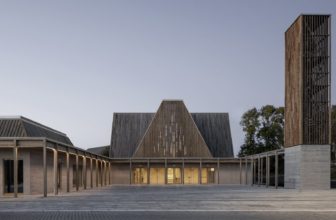The world renowned Bjarke Ingels Group shapes a project for Natural History Museum in Copenhagen, taking on a scope of 38,000 square meters. For more images as well as architects description continue after the jump.
From the Architects:
Rather than trying to add new buildings to existing structures, we propose to add a man-made landscape of stones to the existing buildings in the Botanical Garden. The new Natural History Museum’s architecture will not compete with the existing built heritage. We propose a Natural History Museum as a man-made mineral landscape that naturally adapts ti the historic buildings and their stone pavings and the organic forms of the Botanical. The proposal for the new natural history museum in denmark is a man-made mineral landscape which adapts to the organic forms of the botanical garden situated in the center of copenhagen where the institution is located – their extension is a formation of rocks which intersect with the surrounding green park landscape..above ground, the site’s existing geological garden stands as the public entrance plaza where all services and activities are housed below the overhead perforated stone surface of the new annex. the botanical garden is an addition to the current romantic garden on the premises. this green space gets a discreet cut into the surrounding environment providing garden views from the interior of the structure, while also offering glimpses into the galleries themselves from the exterior.
Both the geological and botanical gardens incorporate exhibition functions underground..the two main programs of the building are the grand whale hall and greenhouses, both of which are sunken into the land and shaped by the structural grid, incorporating exhibition functions underground..the public scopes are housed at ground level making them easily accessible. the grand whale hall – which exhibits some of the oldest skeletons found on earth – becomes the new heart of the museum. the first subterranean level connects all of the buildings already on site to form a continuous exhibition loop which starts and ends with this central area. the galleries and greenhouses within this section receive daylight through skylights in the landscape. the second subgrade level encompasses all spaces which don’t require any daylight intake such as storage spaces and light-sensitive exhibitions.







